The Acropolis of Athens is an ancient hill in the heart of the city and home to some of the most iconic monuments of Greek history, including the Parthenon, the Erechtheion, and the Propylaea.
I am a Greek and an Athenian, and the Acropolis Hill is a part of my soul and a symbol of our rich history.
Here you will find all the frequently asked questions with answers about how to make your visit to the Acropolis smooth and enjoyable!
Travel the Greek Way is an Amazon Associate and participant in other affiliate programs. I earn from qualifying purchases. Please see my disclaimer/privacy policy for more information.
In the meantime, let’s find out all about the Acropolis of Athens!
My Latest Acropolis Video
Heading to the Acropolis of Athens? Let me guide you through the two main entrances—what to expect, which one is better, how to avoid the crowds, and how to get your tickets.
Plus, we’ll walk past the impressive Acropolis Museum!
1. Are the Acropolis of Athens and the Parthenon the Same?
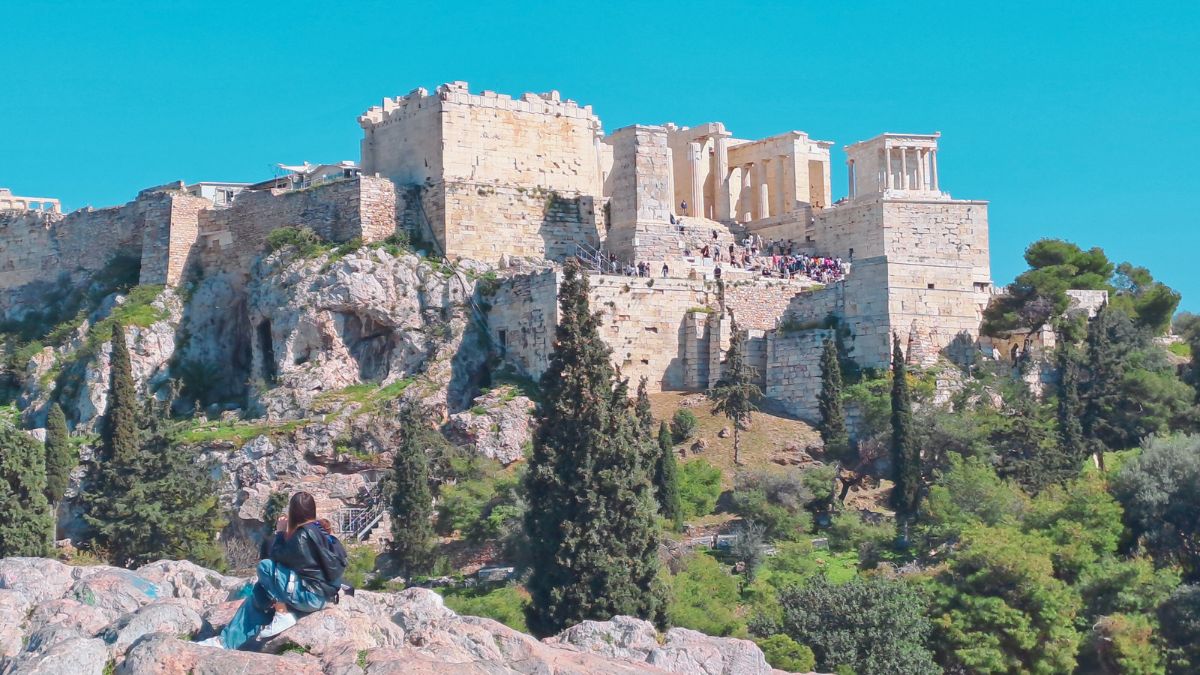
Not exactly.
The Acropolis is a rocky hill, in the center, 156 meters above the Saronic Sea. The Parthenon is one of the Temples dedicated to the goddess Athena that you can find on the Acropolis Hill.
The Acropolis Hill used to be the largest and most stunning complex in Ancient Greece, reaching its peak in the 5th century BCE.
Today, you can see up close the remains of a variety of constructions:

- Few traces from its Mycenaean era.
- Classical Greece Temples devoted to the ancient goddess Athena (Parthenon (Athena Parthenos), Erechtheion (Athena Polias), and Athena Nike (Victorious).
- Monumental Entryways (Propylaea) and the Acropolis Walls.
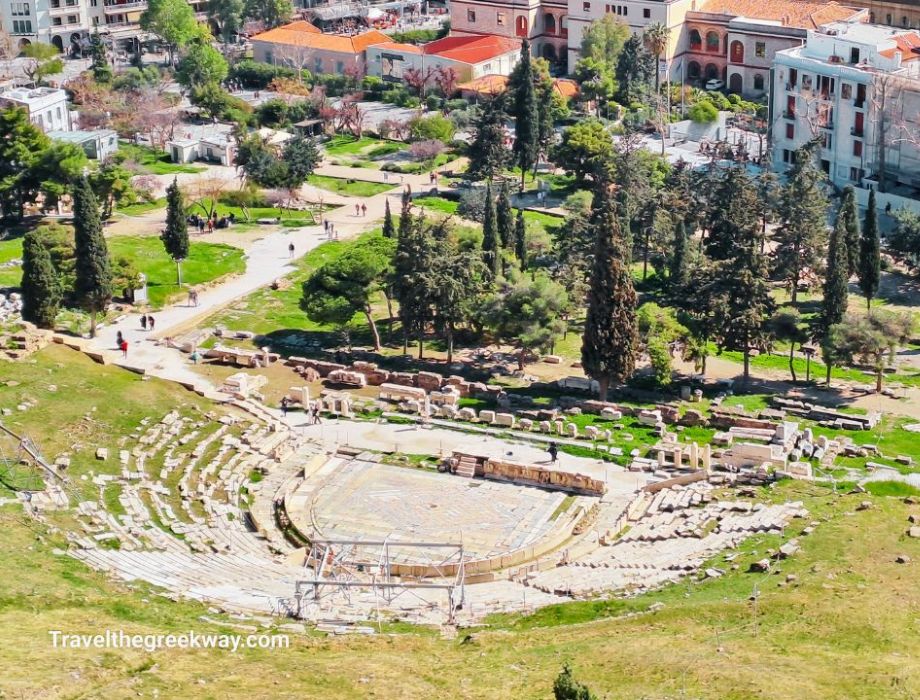
- The Greek Classical Theater of Dionysus Eleuthereus.
- Small Brauronia (or Vravronia) Sanctuary devoted to Artemis (The main Sanctuary of Artemis was in Vravrona).
- Chalkotheke.
- Roman Constructions (Rome and Augustus Temple, Agrippa’s Base, Beule Gate, Odeon of Herodes Atticus).
- Remnants of ruins from its Ottoman era.
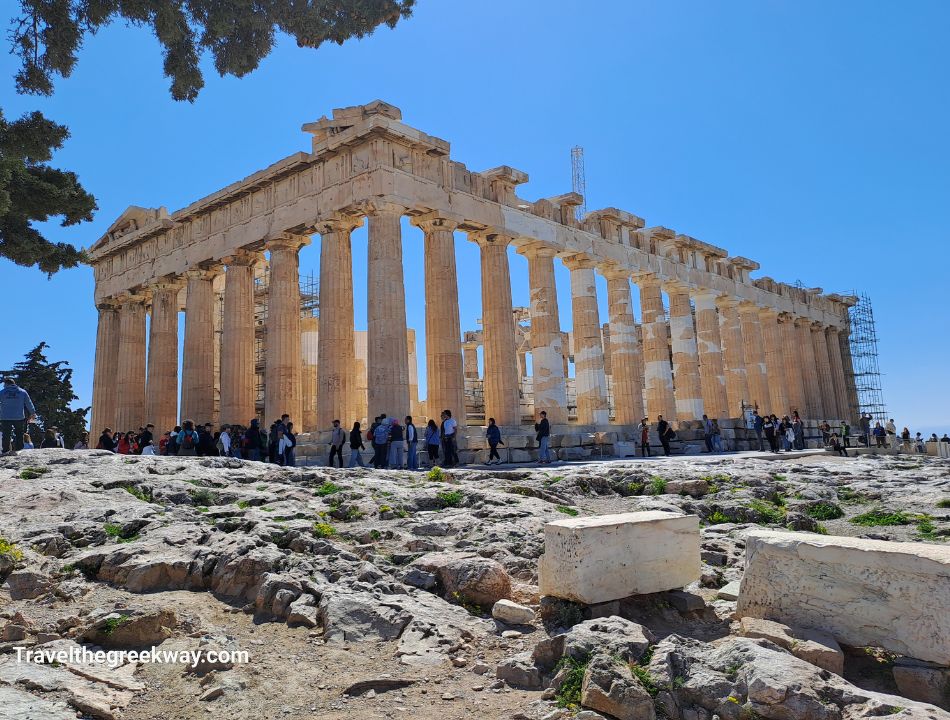
The Parthenon was the main, largest, and most elaborate mixed Doric and Ionic Temple of Acropolis Hill, dedicated to Athena Parthenos (Virgin). It was built between 447 and 438 BCE and was designed by the great architects Iktinos and Callicrates.
The Temple became the center of religious life in Athens and a symbol of Athenian democracy and power. The combination of Parthenon Doric metopes and the Ionic frieze on the walls is considered a unique masterpiece.
2. Why is the Acropolis called ‘Sacred Hill’?
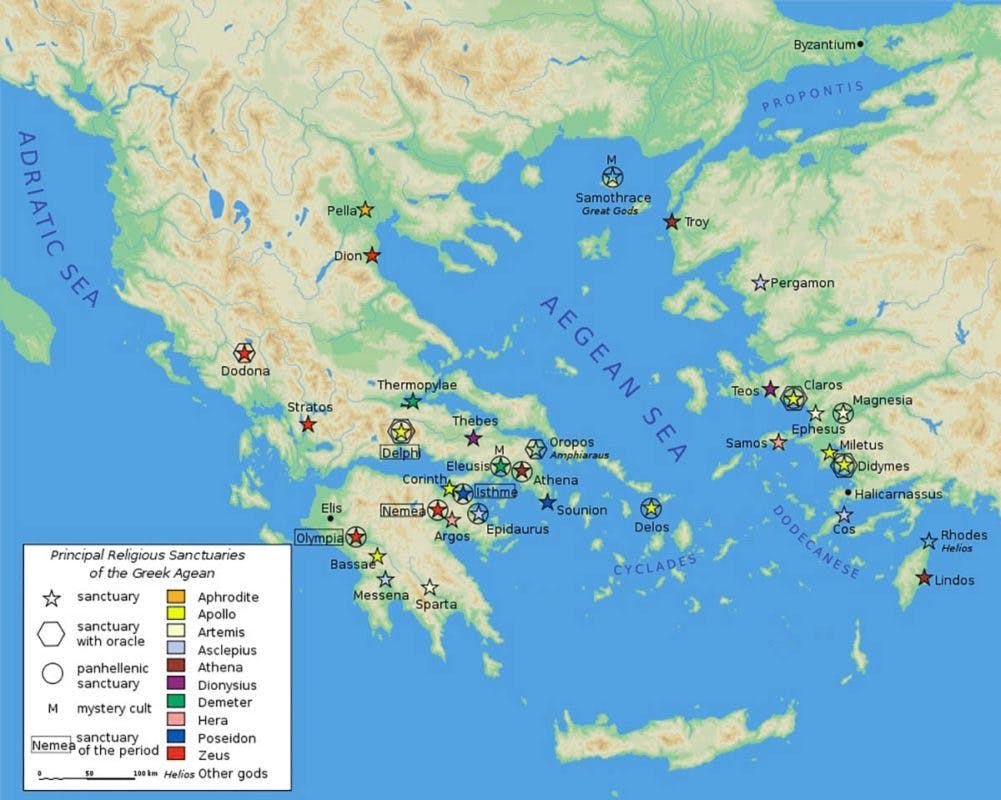
Ancient Greece had many Sanctuaries, five of which were sacred areas in Greece:
- Delphi was the most significant oracle of the ancient Greek world.
- Athens was one of the most powerful and significant ancient cities. Democracy, philosophy, science, legislation, and so more were founded here.
- Eleusina: the Eleusinian Mysteries took place and were one of the most significant religious sites in ancient Athens.
- Olympia in Peloponnese housed the biggest Sanctuary of Zeus and the Olympic Games (to honor Olympian Zeus), and the largest Panhellenic Games took place.
- and Delos island near Mykonos: Apollo was born here, and it was a significant religious center that also evolved into a large commercial hub.
3. Why did the Ancient Greeks build the Acropolis’ Temples?
The Acropolis Hill had always been an important landmark for ancient Athenians, long before the Temples that you see today were built.
There are traces from its Mycenaean era (1650-1060 BCE) when a palace was built on the Acropolis, near the area where the Erechtheion Temple stands.
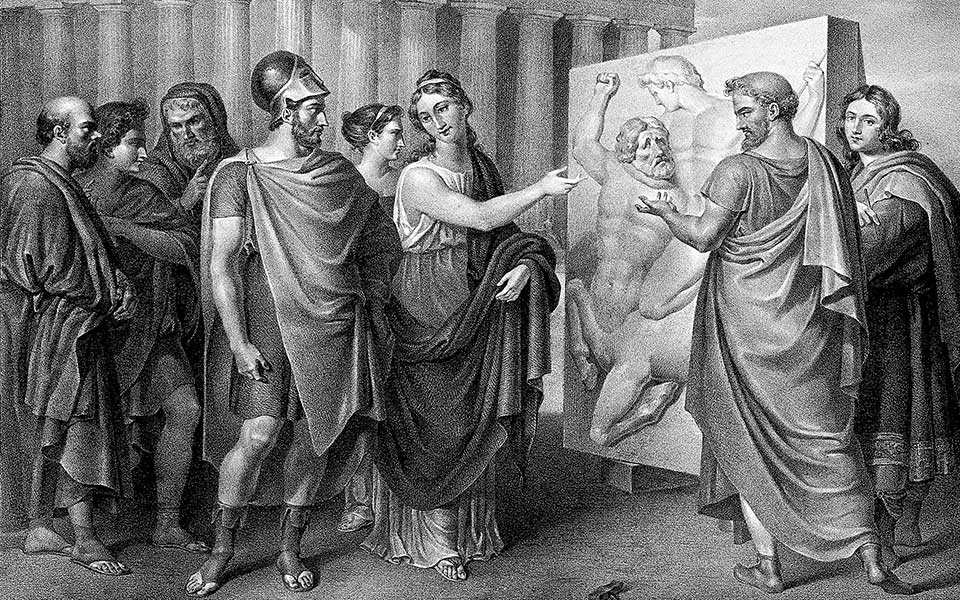
Pericles (c. 495-429 BCE), the ruler and orator, at the peak of Athenian Democracy, launched a monumental construction project in the Acropolis.
They wanted to celebrate the Greek victory against the Persians in Marathon in 490 BCE, and in Thermopylae, Artemisio, and Salamina in 480 BCE.
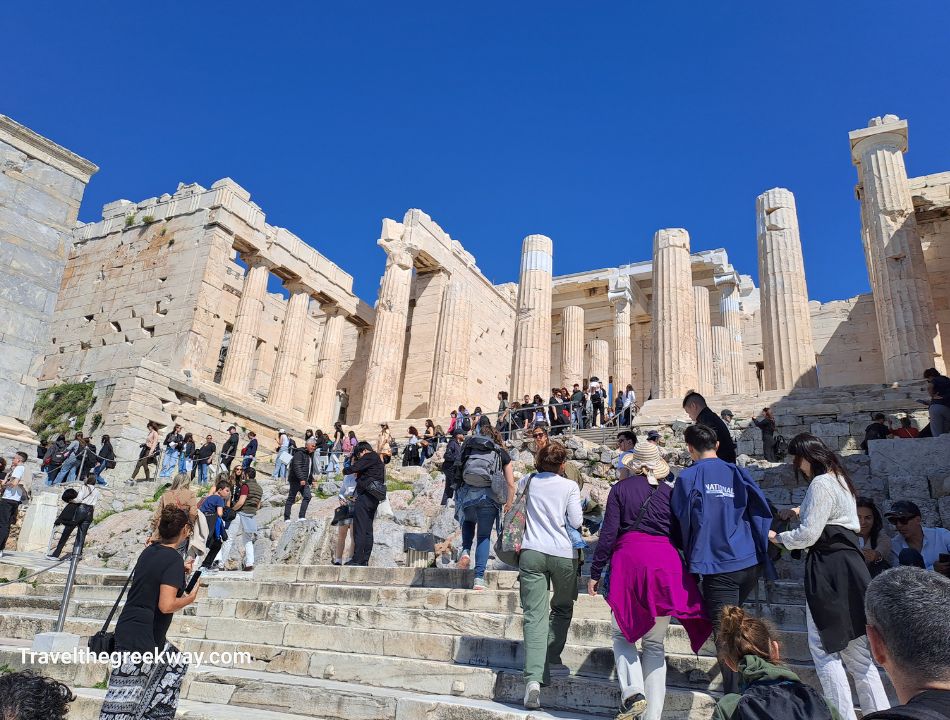
Athens, Acropolis Hill included, was destroyed in 480 BCE by the Persians. Pericles persuaded the Athenian council that they should not only replace the destroyed Temples but also build a monumental Temple for their protector goddess, Athena, as a symbol of their leadership and victory.
After the Greeks’ victory against the Persians, the Athenians were becoming more and more powerful.
Athens, a member of the victorious Greek city-state alliance (the Delian Alliance, from the island of Delos near Mykonos), became a leader, and the other cities started paying taxes to Athens.
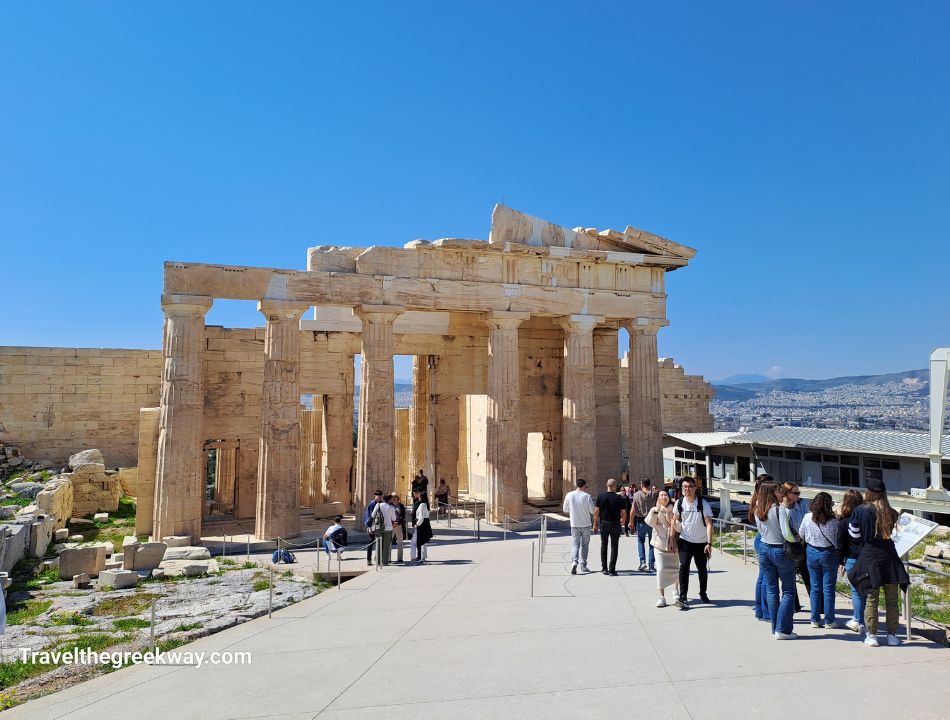
Besides the Temples, a gigantic 12-meter-high statue of Athena was created by Pheidias inside the Parthenon, using ivory and gold.
The statue was removed by the Romans in the 5th century CE, some 1000 years later than after it was erected. A rumor says that it was transferred to Constantinople in the 10th century.
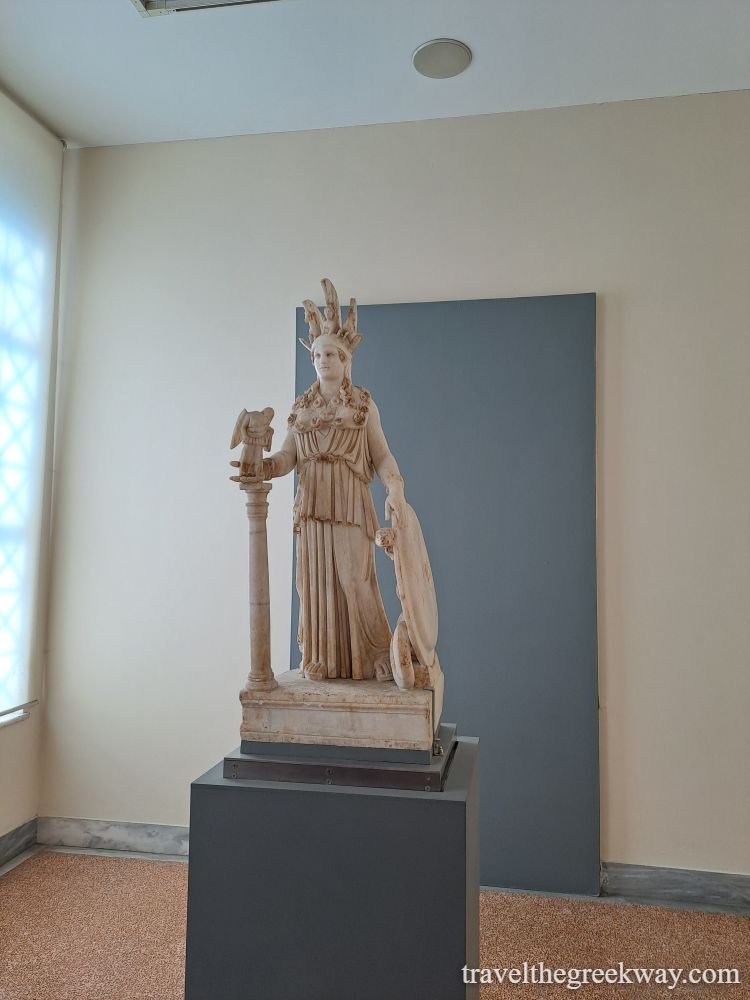
There is no trace left of this statue today, but there are several small-scale Roman copies like the ones in Lenormant and Pergamon.
One Roman replica, the Varvakios Athena – not the most accurate though, as it misses the figures carved on the base – can be seen in the National Archaeological Museum in Athens.
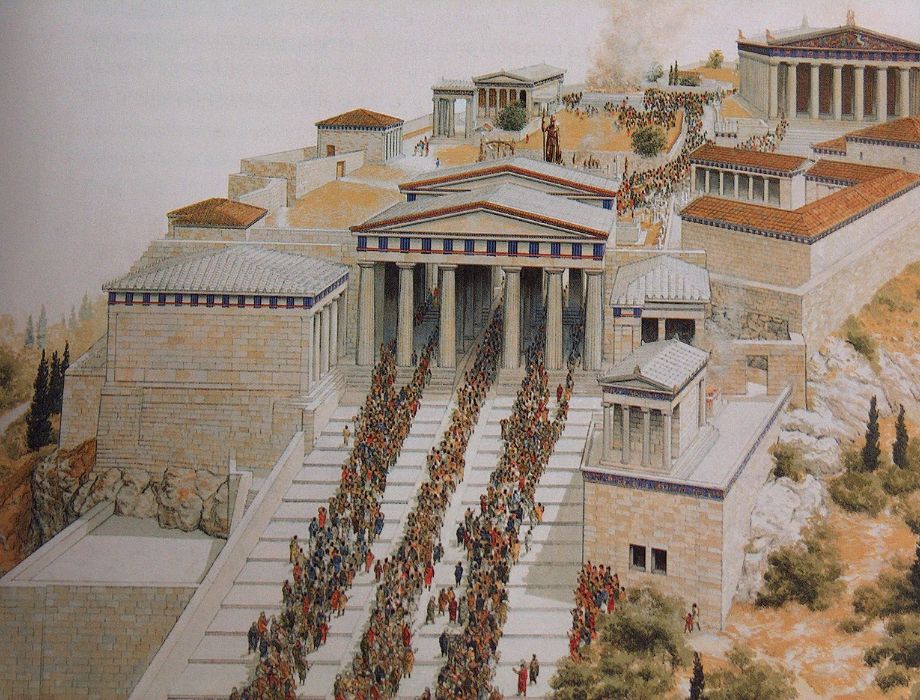
The Parthenon Temple, besides its religious purpose, was mostly a powerful symbol of Athenian Democracy, a War Monument against the Persians and the Hellenic Victory, and through the depiction of the Zoophoros sculptures, a Monument of the power and capabilities of the Athenian citizens.
4. What are the Temples on the Acropolis made of?
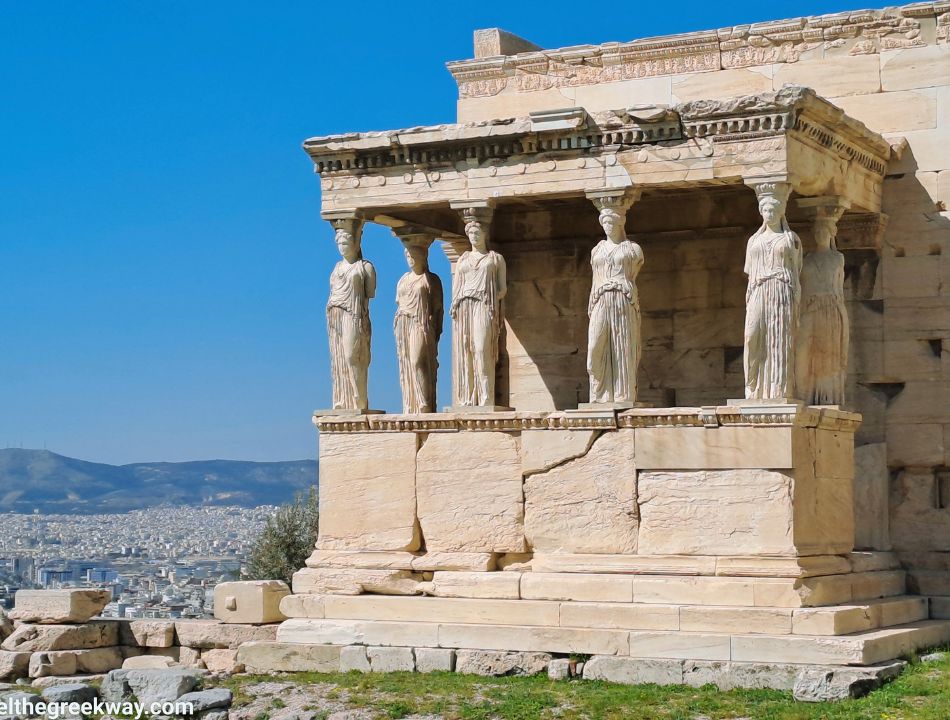
The Acropolis Temples were made from white crystalline marble quarried from Mount Pentelicus, located 10 miles northeast of Athens.
It was built from 15,000 marble blocks of various sizes. Approximately 600 craftsmen and 150 stonemasons were prepared for the transportation.
Possibly among them was Socrates. When he was young, he worked as a stonemason, just like his father, before abandoning this profession “for the sake of education,” as Lucian wrote.
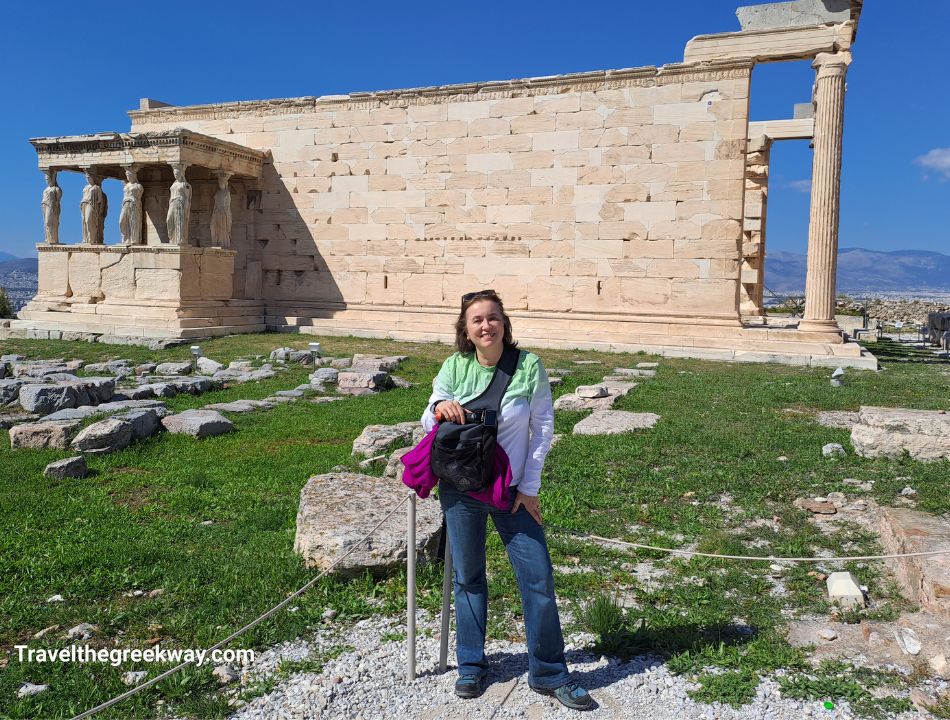
From Mount Pentelicus, the workers using a downhill road had to transport the marble to Athens.
Upon arriving, they had to carry the rocks up the steep slopes of the Acropolis. It must have been a very difficult project for the workers.
5. Where is the Acropolis Entrance?
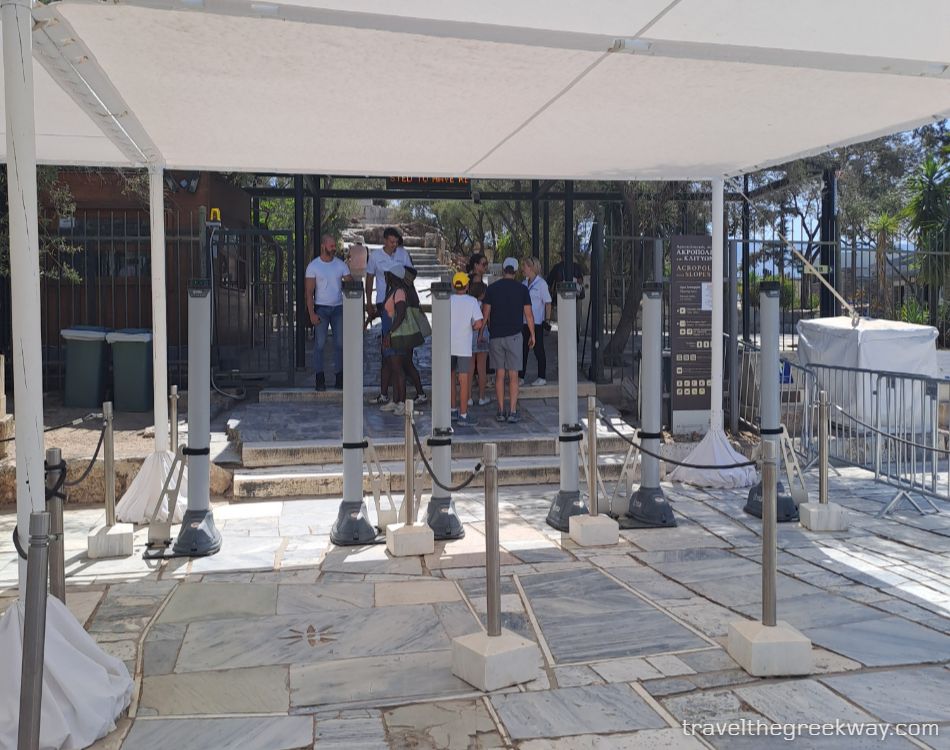
There are two entrances to the Acropolis of Athens:
The northern main entrance is close to Theorias Str. and the southern, at the junction of Thrasyllou Str. and the pedestrian Dionysiou Areoparitou, right across from the Acropolis Museum.
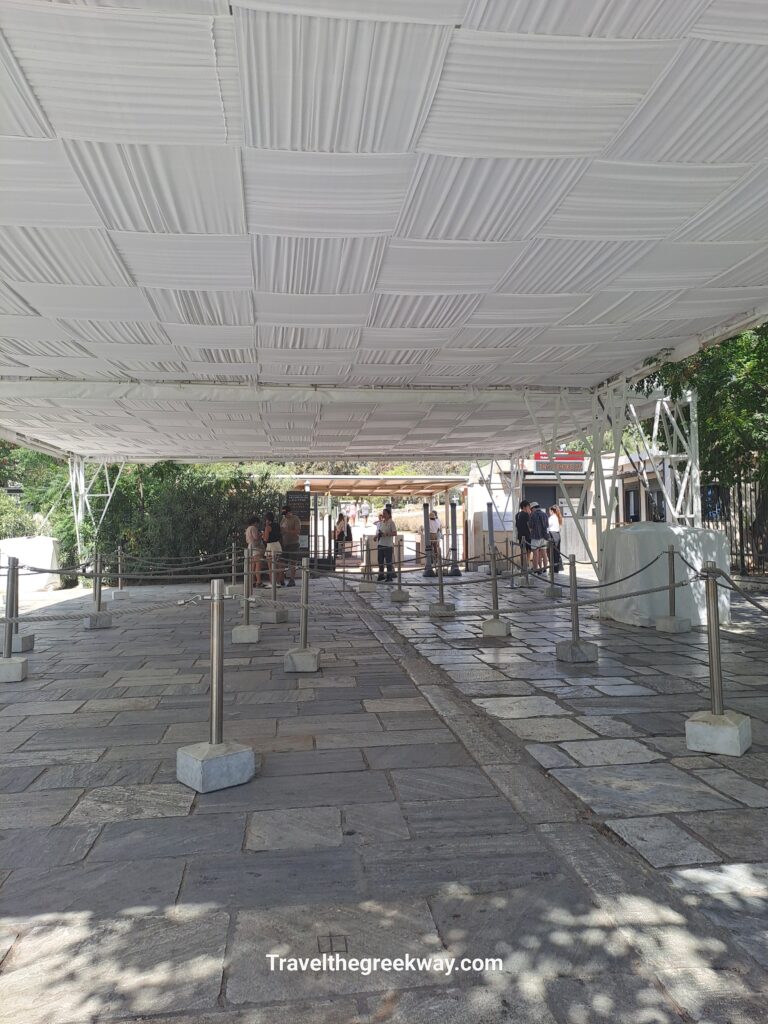
Since the main entrance is right next to Dionysus Restaurant and the main parking area, it’s the go-to spot for tour buses and large groups. The downside? Lines there can get very long.
A better option is the southern entrance — my personal favorite. From there, you can explore the monuments in a more natural flow, and it’s usually much quieter.
Many visitors exit through the main gate and completely miss the southern slopes of the Acropolis — a part well worth seeing.
Book an Acropolis Small-Group Guided Tour with an Entry Ticket
Visit the Acropolis and see Athens’ most famous monuments. Hear fascinating ancient Greek myths from your licensed guide with Get Your Guide! Check availability and prices for this amazing tour here.
6. When is the Acropolis open/closed? When is the Best time to go?
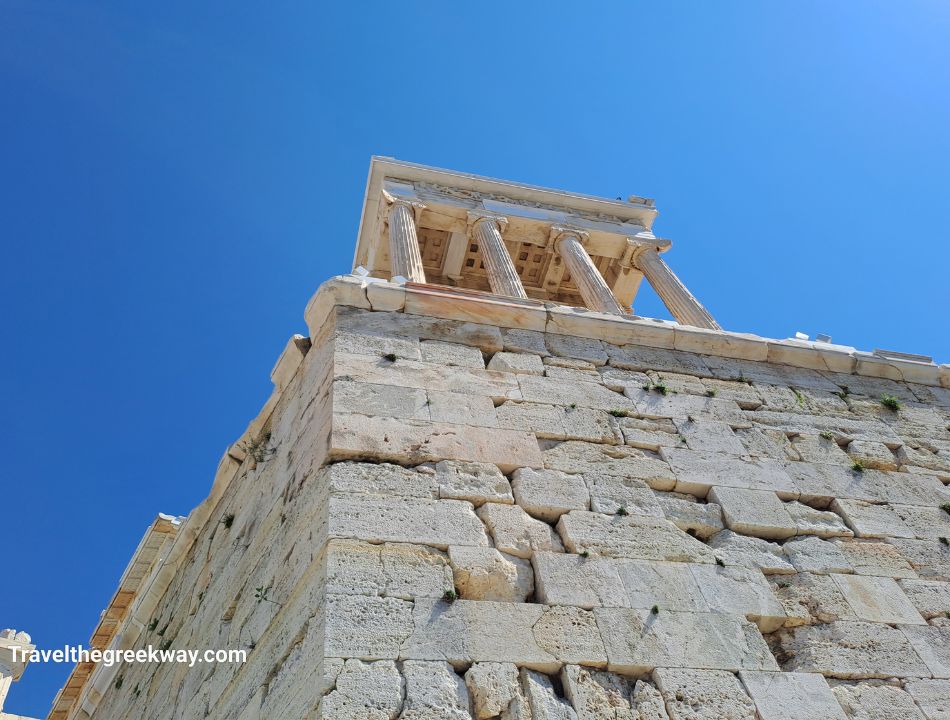
The Acropolis is open daily, with varying hours depending on the season. Typically, it opens at 8 am and closes at 5 pm in winter and 8 pm in summer.
When is the Acropolis closed? The Acropolis is closed on the 1st of January, the 25th of March, the 1st of May, Easter Sunday, and the 25th and 26th of December.
When is the best time to visit the Acropolis?
I suggest you visit the earliest possible (around 8 am) or late in the afternoon (5-6 pm) before closure; you can avoid the busiest times in summer, especially when the crowds from the cruise ships arrive around 10.00 am.
7. How much is the ticket to the Acropolis?
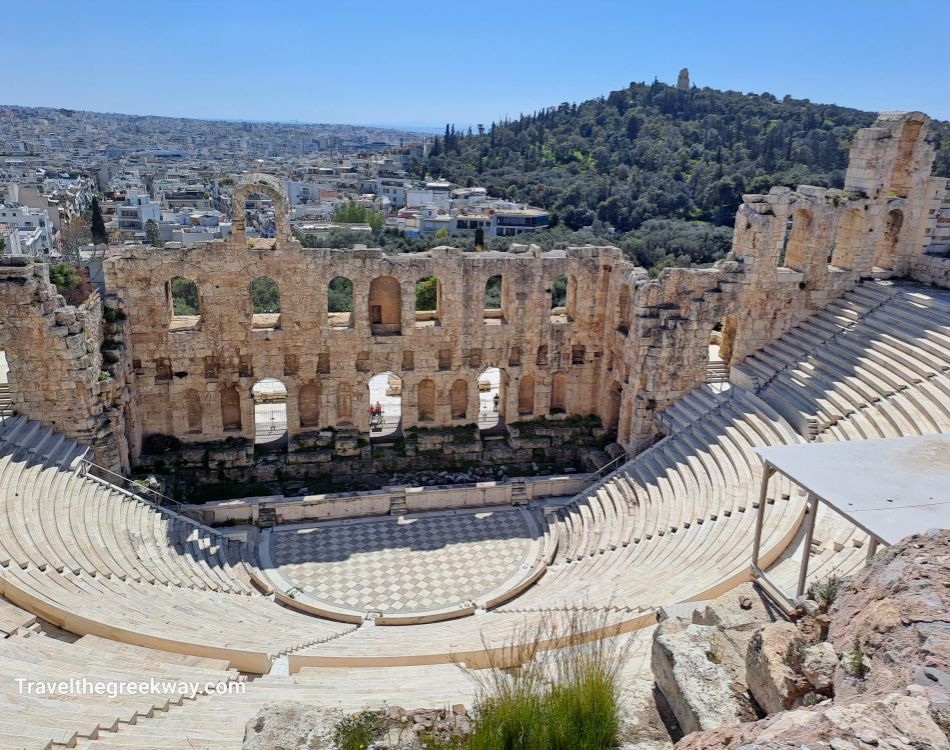
Between April 1st – October 31st, the general admission ticket is €30.
The costs for the other sites are:
- Ancient Agora of Athens and its Museum (€20)
- Roman Agora (€10)
- Kerameikos, Athens’ Ancient Cemetery (€10)
- The Lyceum of Aristotle (€5)
- The Library of Hadrian (€10)
- Olympeio (Temple of Olympian Zeus) (€20).
Certain groups are eligible for half-price or free entrance, usually for EU citizens.
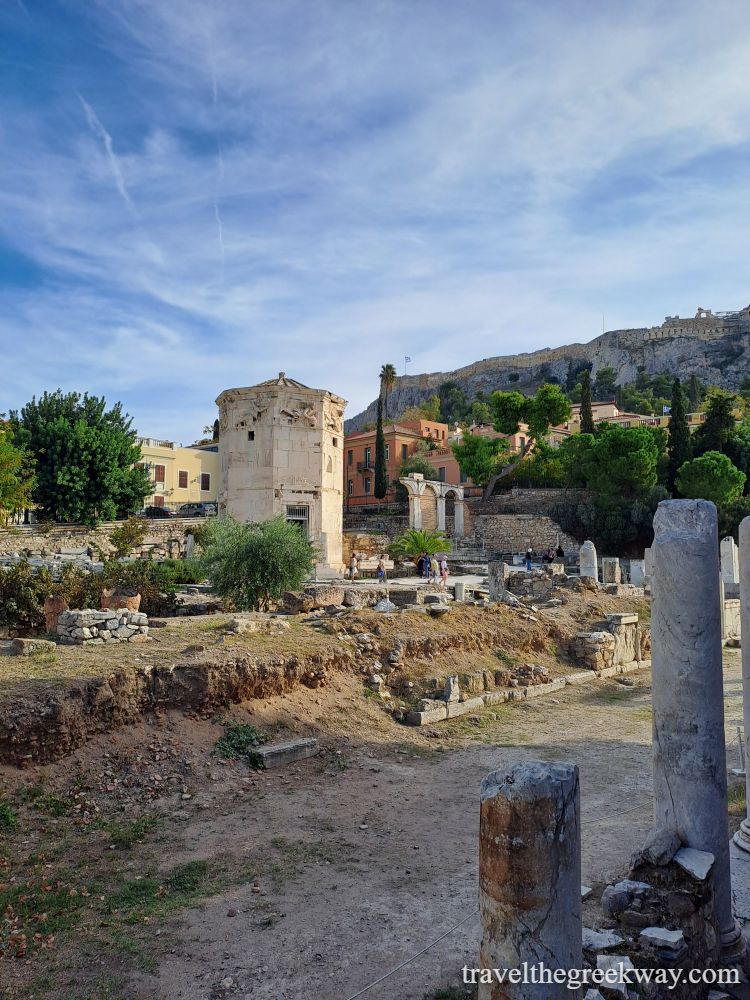
Are there reduced/free admission fees available? Yes, you may be eligible for reduced admission if you’re an EU citizen over 65, or if you’re a teacher accompanying students from anywhere in the world.
Admission is free if you’re an EU resident up to 25 years old, a non-EU visitor up to 18, or if you have a disability of over 67%. Just make sure you bring your ID/passport and any official documents needed to confirm your eligibility.
Free Entrance: From November to March, admission is free on the first Sunday of the month and on the dates March 6th, April 18th, May 18th, the last weekend of September, and October 28th.
- Should I pre-book my ticket even if I travel in winter? Absolutely yes! Even in the low season, lines can be long, and pre-booking saves you both time and hassle.
- Is the Acropolis Museum included in the Acropolis ticket? No, the museum requires a separate entrance fee.
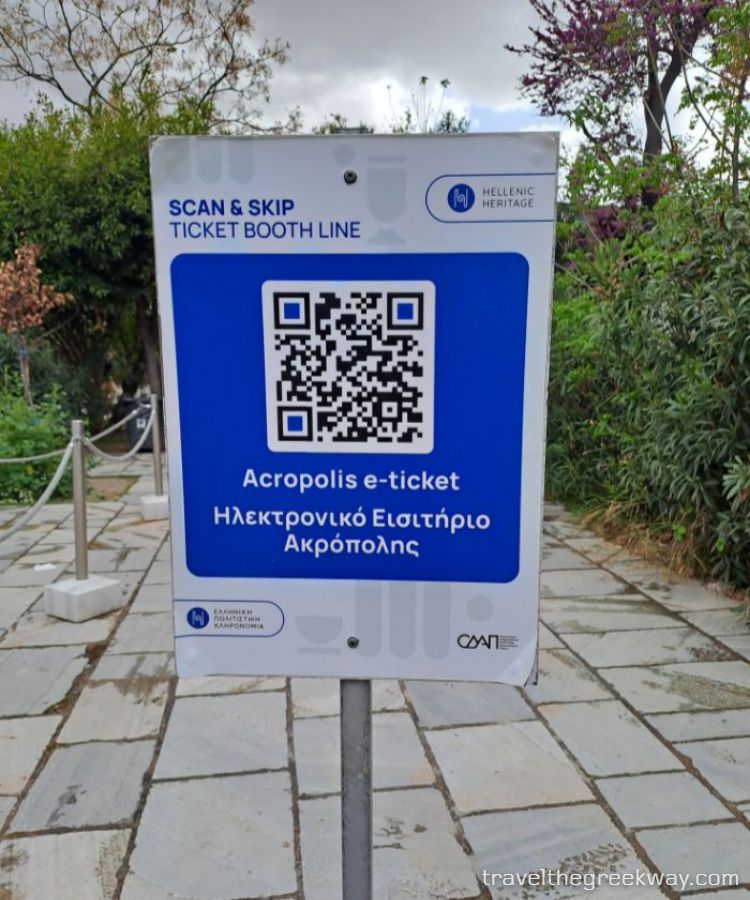
- What about “skipping the line”? Everybody needs to wait in line to get their ticket checked before entering. The only “skip the line” service is that you can scan your ticket on this sign and perhaps save some time while trying to get into the Acropolis.
- Can I re-enter the Acropolis on the same day with the same ticket? No, standard tickets allow a single entry only.
Can I purchase tickets online?
You can buy your tickets directly from the official Acropolis website, but keep in mind they are non-refundable and you can’t change the date once booked.
If your plans aren’t 100% fixed, it’s safer to book through platforms like GetYourGuide or Viator, where you usually have more flexibility.
What is the Acropolis Experience?

For 5,000 euros, the Acropolis Experience offers a once-in-a-lifetime chance to explore this masterpiece of Greek architecture in total privacy.
You and your group can have the entire Acropolis to yourselves, soaking in the breathtaking sunrise or sunset with unbeatable city views. This exclusive experience is limited to just four private groups (up to 5 people each) at a time.
Your VIP visit includes a personal tour guide and a licensed reproduction of an ancient Greek artifact—a unique keepsake to bring a piece of classical antiquity home.
Discover Acropolis Experience here.
8. Parthenon throughout the centuries. Destruction in many parts…
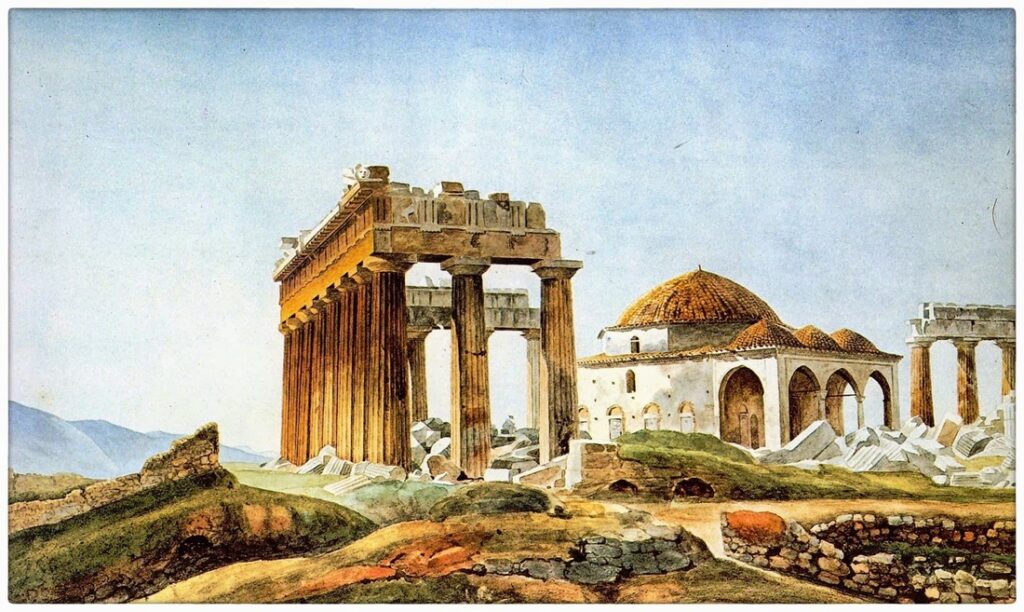
Christianity was legalized in Greece in 313 CE, and by 392 CE, Emperor Theodosius I had banned the practice of the ancient Greek religion.
Later, in 435 CE, Emperor Theodosius II went a step further — he ordered the destruction of ancient temples and sanctuaries. However, the most important ones, like the Parthenon, were spared and converted into Christian churches.
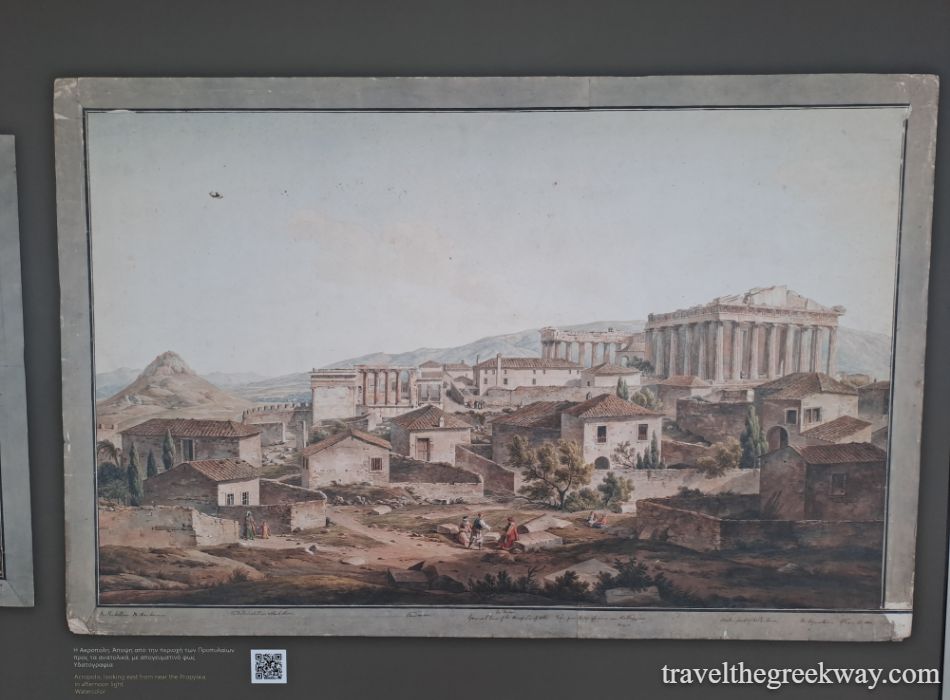
The Parthenon Temple was turned into Panagia the Athiniotissa (Virgin Mary of Athens) Christian church, a three-aisled basilica in the late 6th century CE.
The Christians knocked out the eastern wall of the cella to make an apse, knocked off heads, and did other damage to the sculptures, especially the metopes, because of the pagan subjects.
During the Latin Occupation, in 1204 CE, and for 250 years, the Parthenon was turned into a Roman Catholic church.
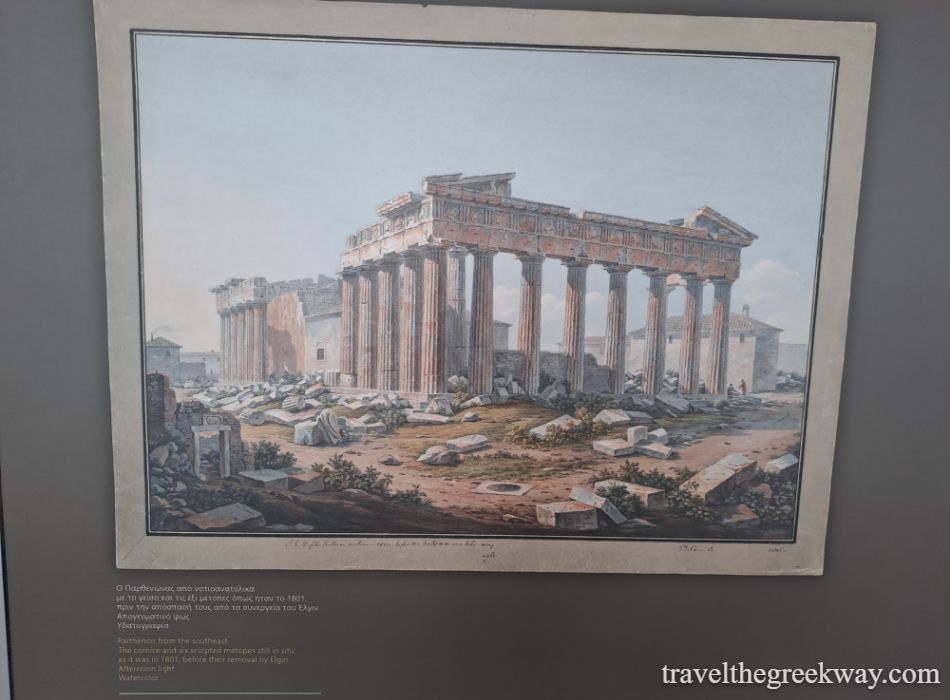
In 1458, when the Ottoman Sultan came to Athens, he turned the Parthenon into a mosque. The Ottomans used some of the metopes for target practice.
In 1687 Parthenon was bombarded by the Venetians (more in question 9).
In 1801, Elgin removed half of its friezes and metopes (more in question 10).
In 1822, the Ottomans broke the pillars to remove the iron they knew the ancient Athenians had used to secure the pillars.
In 1833, the Acropolis was finally liberated by the Greeks.

In April 1941 Acropolis was desecrated by the Nazis when they raised their swastika flag on the east edge of the Acropolis. On May 30th, 1941, two brave 18-year-old university students, Manolis Glezos and Lakis Santas climbed to the Hill and took the Nazi flag down.
Their brave act inspired many others to create resistance groups against the Nazis.
Lakis Santas died in April 2011, and Manolis Glezos in March 2020, and were both buried like Greek heroes.
There is a Memorial plaque of this event on the east side of the Acropolis near the raised Greek flag.
9. Why is the Southern Wall of the Parthenon Missing?
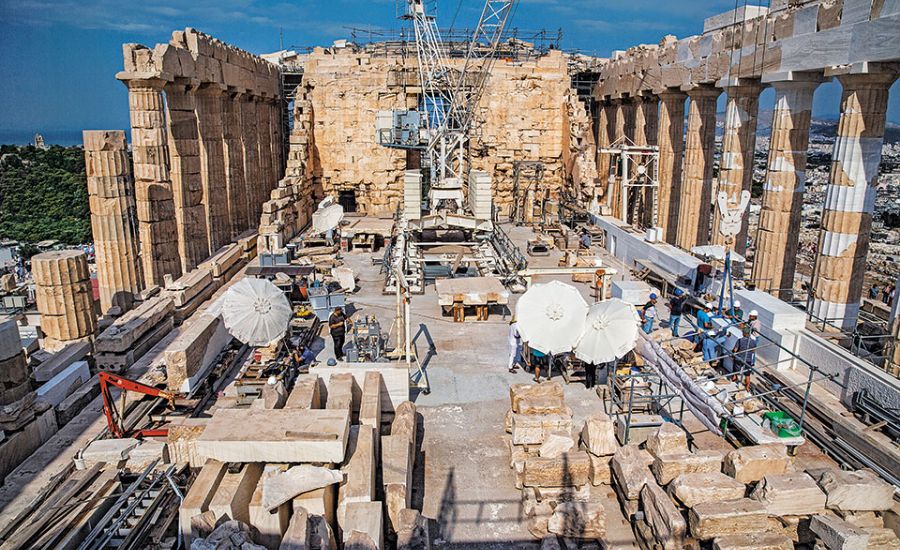
The Parthenon may have been almost 2,000 years old in 1687 CE; however, it was still in very good condition, with all walls standing and all its decorative marbles more or less in place.
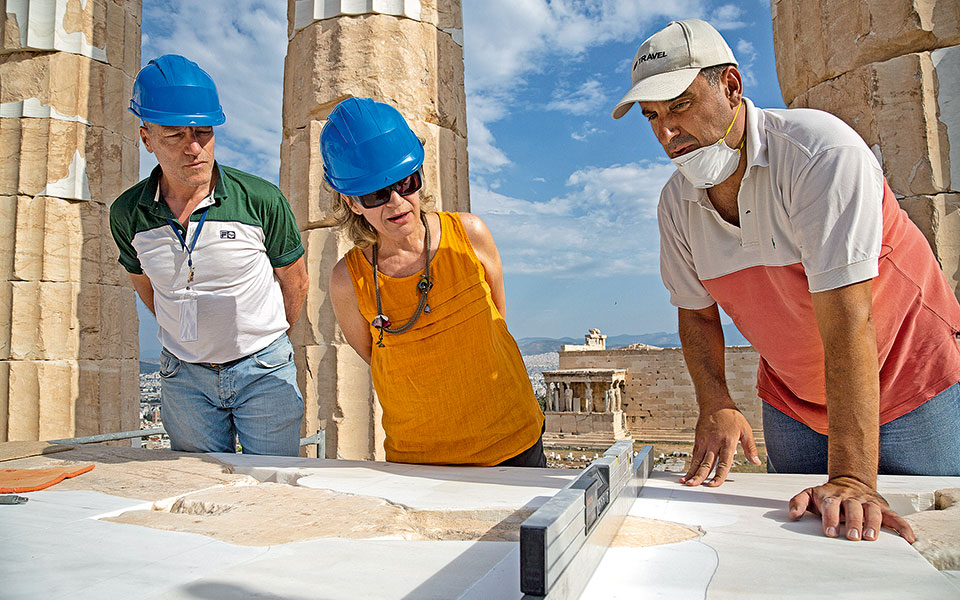
In 1687, the Venetians under the rule of Morosini seized the Acropolis. Morosini knew that the Ottomans used one of the Parthenon rooms to store the powder gun and he bombarded the Parthenon, destroying all but one of its four walls.
The Parthenon roof also collapsed. However, there is a 15-year restoration program of the northern wall of the Parthenon’s cella.
10. Why are the Parthenon Marbles in the British Museum?
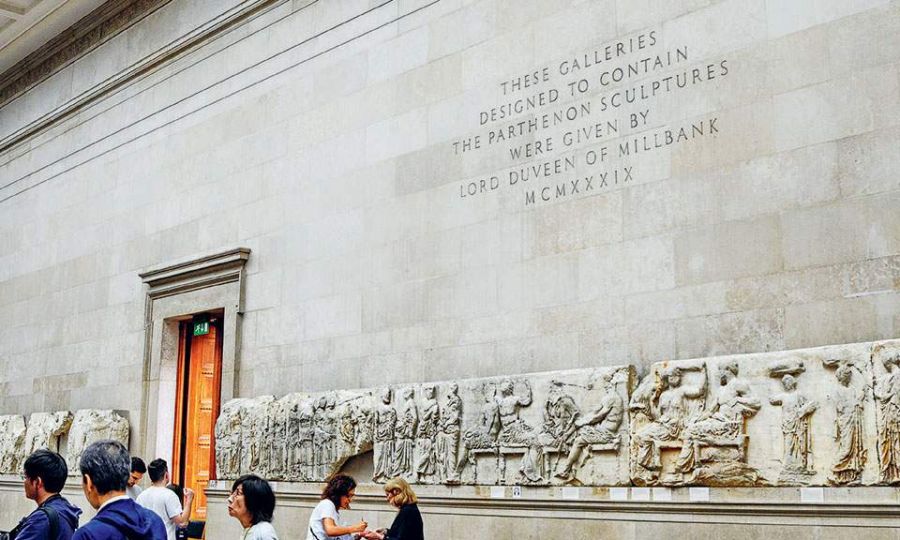
Parthenon was further damaged by Elgin between 1801 to 1803 when he violently removed, cutting them with a saw, about half of the surviving sculptures of the Parthenon, as well as sculptures from the Propylaea and one Caryatid from Erechtheion.
He, later on, sold the Parthenon Marbles to the British Museum, where they are still kept. The Greek government has been trying for over 40 years to persuade the British Museum to return the Parthenon Marbles, where they belong, in Greece.
There are also two pieces from the Parthenon marbles, a frieze and a metope, in the Louvre Museum.
11. Why are the Parthenon Marbles Important?
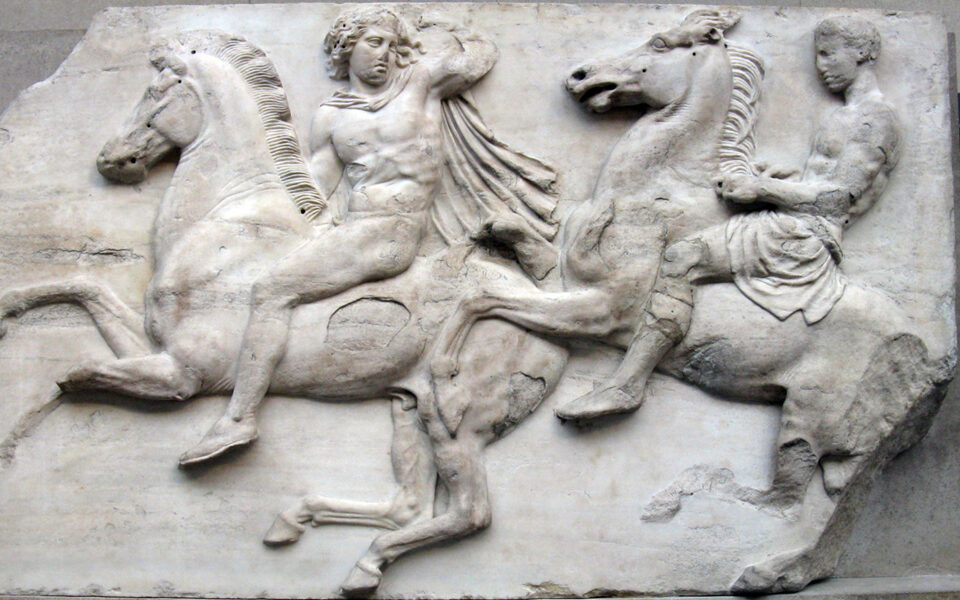
The sculptures were set around the top part of the gigantic Parthenon, a 160-meter-long frieze consisting of 378 human and god figures, and 245 animals, and are considered masterpieces of utmost beauty and artistic perfection.
The frieze (Zoophoros) was, probably, a sculptural story of the annual religious procession that was taking place in Athens, called the Panathenaic Procession.
The marble represents the height of Ancient Greek civilization, democracy, and architecture. The temples and monuments here have influenced world art and design for centuries.
12. Are there any Sculptures Left on the Parthenon?
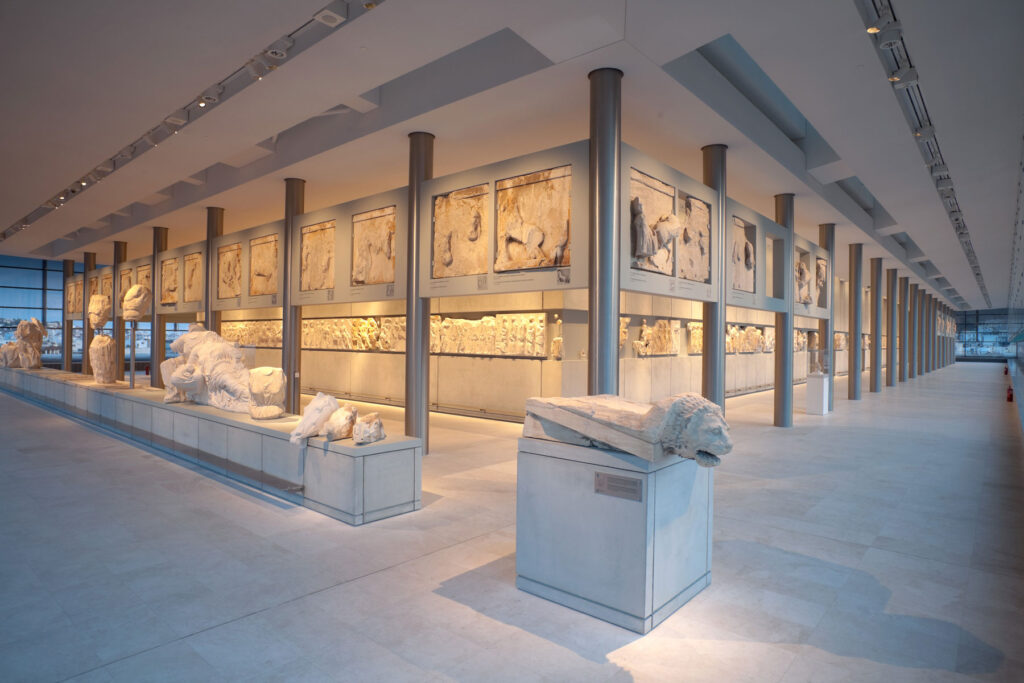
No, there are no marble sculptures left on the Parthenon.
Everything you see on the site is plaster casts and the original sculptures have been moved into the Acropolis Museum to protect them from air pollution.
13. I am a Mobility-Challenged Person. Can I Visit the Acropolis?
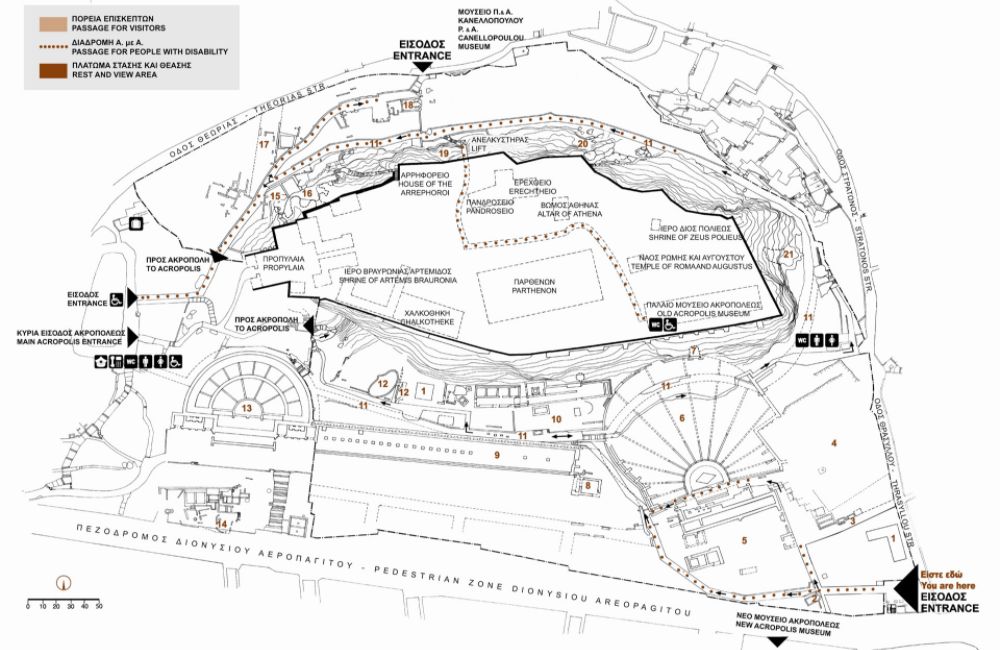
Yes, there is a new Acropolis elevator, and improved wheelchair-friendly paths were installed in 2020, but you need to go to the main entrance of the Acropolis, right above Dionysos Parking, to access it.
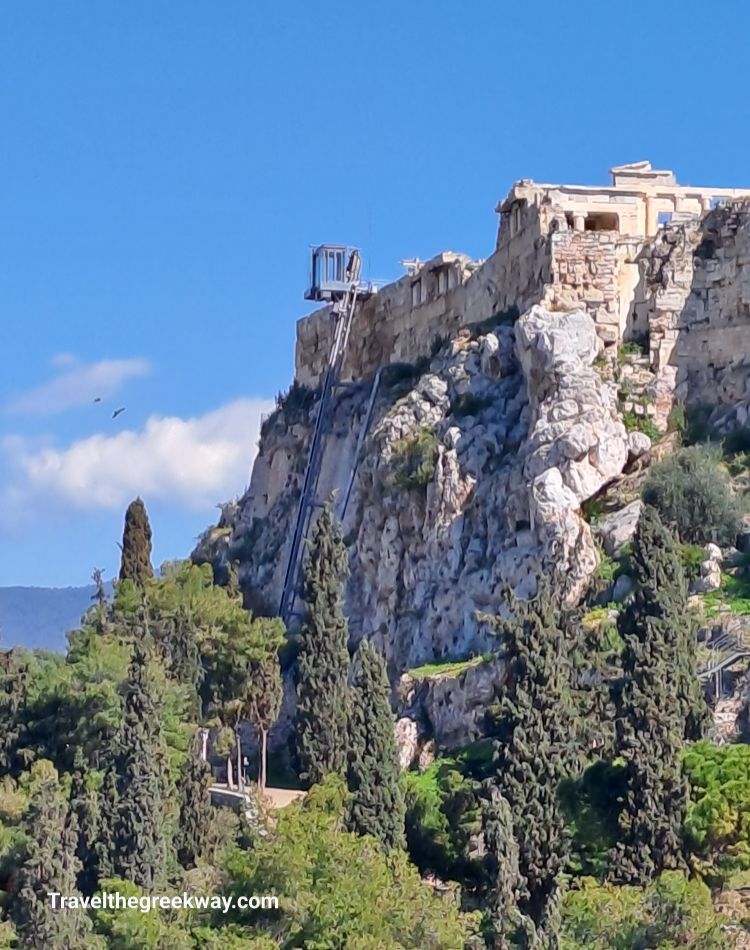
There are signs guiding you towards the entrance and the elevator as well but in case you can’t find it, when you get to the entrance gates, get your entrance ticket and afterward ask the guides for directions on how to get there. The entrance to the lift is a minute from the ticket booth.
There is always someone at the exit gates who can help you with the lift. The lift will take you straight to the top of the Acropolis, where the Temples are.
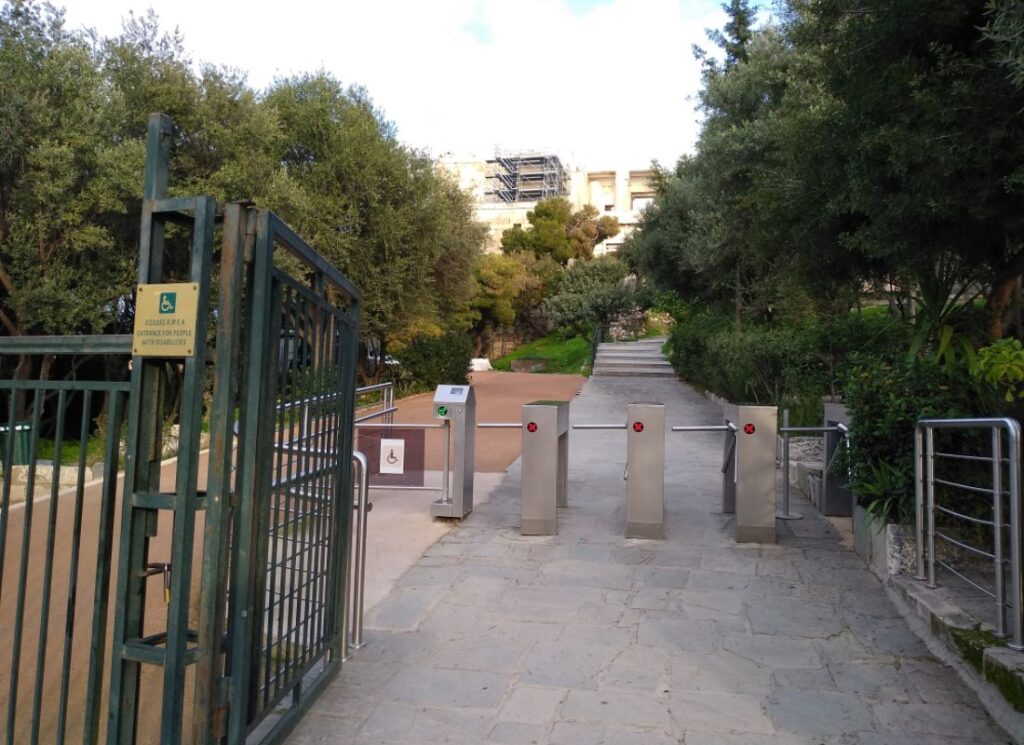
To use this service, you’ll need to call in advance before your visit around 8 in the morning, to confirm that the lift is in service (+30 210 3214172, +30 210 9238470).
⚠️ The service is not available during severe weather or strong winds.
You may also enjoy: Accessibility and Greek sites
14. Does the Acropolis have a dress code?
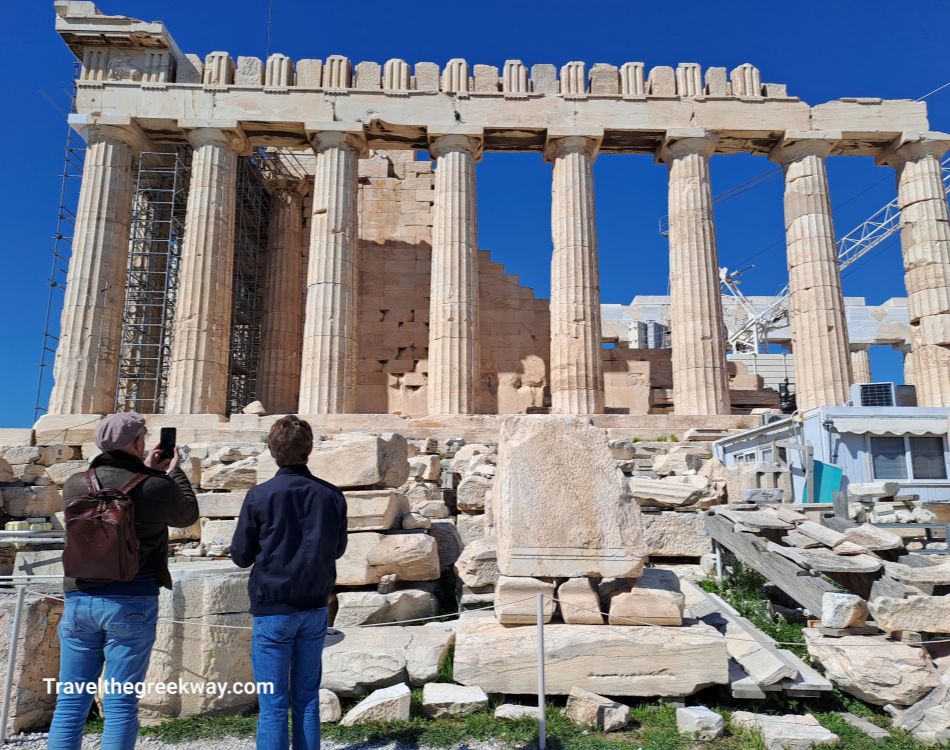
There’s no dress code for visiting the Acropolis, unlike in Greek monasteries such as those at Meteora. My suggestions for what to wear to the Acropolis are:
- In summer: bring a hat, comfortable clothes, good walking shoes, sunscreen, and plenty of water.
- In winter: remember that it’s a hill, so it can get windy and cold. If it has rained, the marble steps can be slippery. Wear good walking shoes and warm clothing.
15. Is There Anything that is not allowed in the Acropolis?
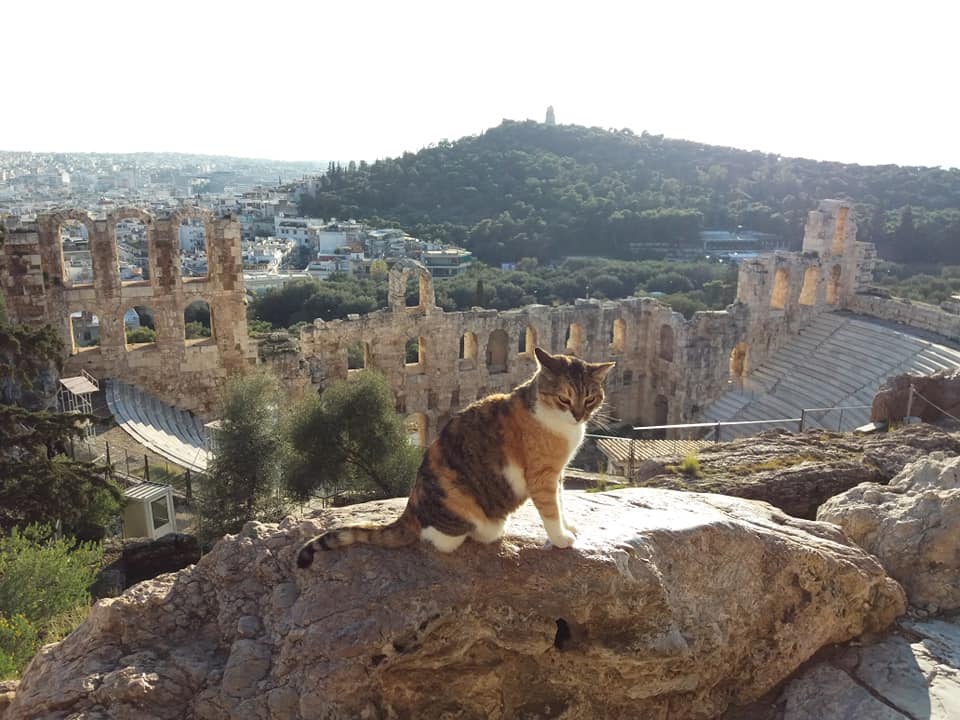
🚫 What’s Not Allowed at the Acropolis
- Do not touch the marble surfaces. It might feel like regular stone, but even a light touch can harm it over time.
- Acropolis Bag Policy: Backpacks and large bags must be left at the check-in area before you enter. You’re only allowed a small bag—for water, phone, and wallet.
- No baby strollers are allowed inside the site.
- Pets aren’t allowed unless it’s a certified guide dog.
- No eating or drinking (except water). Sodas, snacks, and food are not allowed inside the archaeological area.
- No smoking or vaping anywhere inside.
- No music or loud sounds. Please keep the area peaceful.
- No commercial photography without special permission.
- Do not move, damage, or take anything from the site—including ancient objects, natural items like rocks, or even modern things.
- Don’t wander outside the designated paths. Leaving the marked routes or straying away from the archaeological site is prohibited and can get you into serious trouble.
🔍 Anyone breaking these rules may face legal consequences under Greek archaeological law (Law 4858/2021). Please be respectful!
16. What facilities are there on the Acropolis?
There are public toilets (restrooms) outside of the northern entrance and also across from the Parthenon Temple, where the old Acropolis Museum building is.
In the Information Center, at 18-20 Dionysiou Areopagitou Str., about 50m out of the entrance of the South Slope of the Acropolis, a WC for the physically challenged is also provided.
There are also machines to buy water bottles (€0.50 per bottle), a lift, and a small medical center.
17. Is the Acropolis of Athens the only Greek Acropolis?
Acropolis means the edge of a city and is usually located at the highest point of a city.
Greece has many significant Acropolises all around the country such as:
- Acrocorinth in Ancient Corinth.
- Lindos Acropolis on Rhodes.
- Acropolis in Argos.
- Tiryns Acropolis in Nafplion.
FAQs
I have only one day in Athens — where should I go?
Here’s my 24-hour guide to the best sights, neighborhoods, and experiences so you can make the most of your short stay.
Are there medical services available at the Acropolis?
Yes, there are medical services on-site for emergencies.
How long does a visit to the Acropolis typically take?
A full visit usually takes 1.5 to 2 hours, depending on your interest and pace.
Are drones permitted at the Acropolis?
No drone usage is strictly prohibited over archaeological sites in Greece.
What languages are the informational signs in?
Signs are primarily in Greek and English.
Is there parking available near the Acropolis?
There are only a few paid parking options. I suggest taking the metro (Line 2) to the Acropolis station instead.
What other attractions are near the Acropolis?
What other attractions are near the Acropolis?
Nearby attractions include the Acropolis Museum, the Ancient Agora, and the Plaka neighborhood.
Can you wear shorts to the Acropolis?
Yes, Yes — there’s no dress code at the Acropolis, so you can definitely wear shorts.
Where to Stay in Athens
The Dolli at Acropolis is a stunning 5-star hotel located inside a beautiful building from 1925. The rooms are stylishly decorated with art pieces, with high ceilings and stunning Acropolis views.
The wow factor of this hotel for me is the top-roof swimming pool that reflects the white marble of the Parthenon pillars.
For more hotel choices, please check my list below:
Wrapping up
I hope this FAQ has answered all your questions about visiting the Acropolis!
Whether you’re planning your first trip or returning for another visit, being prepared will help you make the most of this incredible experience. Enjoy your time exploring one of Greece’s greatest treasures!
Join Our FB Group & Subscribe to My YouTube Channel!
For more travel to Greece tips and beautiful destinations in the Greek islands please join my FREE Facebook Group or SUBSCRIBE to my YouTube & TikTok channels for amazing videos of Greece! Happy and safe travels, Evgenia.
How to Get to Athens Port (Piraeus) from Athens Airport

- Bus: If you are arriving at Athens International Airport you can travel straight to the port by taking the X96 express bus (€5.5, children <6 yo, free entrance), which departs every 40 minutes and the average trip lasts 1 hour – runs 24/7.
- Metro: (€9) is easily found across airport arrivals (blue line – M3) going directly to Piraeus port. The average trip to Piraeus lasts 1 hour.
- Taxis are available in front of the airport (around €45 to Athens, €55 to Piraeus (depending on the traffic in Kifisos), and take up to 3 or 4 people with small luggage)
- Rent a car with Discover Cars for reliable, new cars at affordable prices
- You don’t like driving but love hassle-free solutions? Book a Private transfer with an English-speaking driver from Athens International Airport to Piraeus Ferries, or anywhere else in Greece.
Some of my Favorite Travel Resources for Greece
- ‘Hello’ and ‘Thank You’ in Greek: “Ya sou” and “Efharisto”
- Booking.com: I use Booking.com mostly for Europe.
- All-Inclusive Resorts in Greece
- FerryScanner to book ferries to the Greek Islands
- Rent an Affordable Car in Greece
- Athens Metro Website (timetables and ticket info)
- Trains (Hellenic Train)
- Public Buses KTEL
- Get Your Guide: For all your day or multi-day tours and city guide needs, I use Get Your Guide
- Emergency Numbers Anywhere in Greece: AMBULANCE 166 – FIRE 199 – POLICE 100– EMERGENCY NUMBER 112

Is it true that visitors can not wear backpacks at the acropolis?
If yes, can we wear shoulder totes for our water bottles, windbreaker, sunscreen, my collapsible cane (I have a bad hip that sometimes acts up), cooling cloth, etc.
We are going to Athens in October 2023.
Hello Lynn
Yes, it is true, and thank you for pointing this out. All big backpacks will be left at the check-in at the entrance of the site. You can only carry small bags with your bottle of water or purse. You don’t need a windbreaker and cooling cloth in Acropolis in October, it will be cooler. Just get water, and a hat and apply sunscreen at your hotel before you get into the Acropolis.
Thank you and wish you have a great time in Athens 🙂
Evgenia